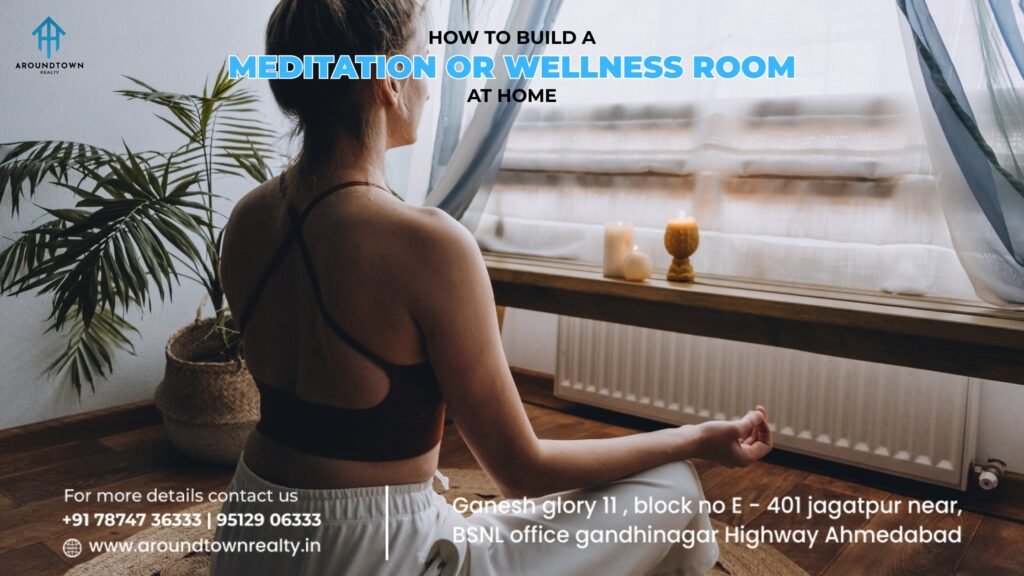Introduction: How to Build a Meditation or Wellness Room at Home
In an age where digital distractions dominate and stress levels surge, creating a wellness zone at home is becoming a vital part of modern living. More than just a design trend, a dedicated meditation or wellness room offers a tangible solution to mental clutter, emotional fatigue, and urban chaos. Whether you’re in a 2BHK apartment in Ahmedabad or a villa in Gandhinagar, you can carve out a soulful corner that helps you breathe better, think clearer, and simply be.
This guide walks you through the process of creating a meditation room at home—from space selection and design philosophy to sensory additions and cultural integrations. Ready to build your zen zone? Let’s dive in.
1. Identify and Prepare the Right Space
The first and most crucial step in creating a wellness or meditation room is choosing the right location within your home. You don’t need a lavish extra room—just a space that allows peace, privacy, and minimal interference.
Key Tips:
- North-East Corner: According to Vastu, this is the most spiritually charged zone of the house, ideal for meditation and yoga.
- Spare Bedrooms: Underused guest rooms can be transformed into fully functional wellness sanctuaries.
- Balcony Extensions: High-rise apartments in cities like Ahmedabad often have enclosed balconies—these can be converted into soothing wellness nooks with privacy curtains and vertical gardens.
- Partition a Section: In compact homes, you can use a wooden screen, bamboo divider, or open shelf unit to cordon off a small section for meditation.
Prepare the area by removing all unrelated items, deep-cleaning the floor and walls, and ensuring it’s free from electrical distractions like routers or televisions.
2. Embrace Natural Light and Ventilation
Light and air are two non-negotiables in a wellness setup. Natural sunlight not only enhances mood but also boosts vitamin D, a critical hormone regulator.
Ahmedabad-Specific Insight:
Given the city’s abundant sunlight, place your meditation zone near east-facing windows to welcome the morning light. Use khus curtains or sheer linen blinds to diffuse harsh rays during summer months while maintaining brightness.
For air, allow for cross-ventilation. If natural airflow is limited, install a low-noise air purifier to ensure the air remains fresh and breathable.
3. Choose a Calming Color Scheme
Color psychology plays a powerful role in regulating emotions. Your wellness room should feature colors that soothe rather than stimulate.
Ideal Color Palettes:
- Pastel Greens and Blues: Evoke serenity and closeness to nature.
- Soft Whites and Beiges: Offer a clean, distraction-free environment.
- Dusty Rose and Lavender: Perfect for relaxation and feminine energy.
- Terracotta and Earthy Browns: Bring grounding and warmth, especially in colder climates.
Use these on walls, cushions, floor rugs, curtains, or even small planters to tie the space together.
4. Integrate Minimalism with Meaning
Less is truly more in a meditation space. You’re not just creating a room—you’re curating energy. Strip down the area to the bare essentials to avoid clutter, which subconsciously increases anxiety.
Essentials Only:
- One yoga mat or rug
- One meditation cushion or chair
- One low-rise table for candles or incense
- One indoor plant
- One storage box for wellness tools
Avoid including electronics, bookshelves, or decorative items that don’t serve a wellness purpose.
5. Add Culturally Rooted Wellness Tools
Bring in elements that reflect your own spiritual or emotional practices. The key is to choose items that align with your daily rituals.
Options to Consider:
- Singing Bowls or Bells: Enhance focus through sound vibrations.
- Dhoop or Essential Oil Diffusers: Set the sensory tone of the space.
- Prayer Mats, Statues, or Mala Beads: Perfect for those who blend prayer with meditation.
- Journaling Table: For reflective writing, daily affirmations, or gratitude notes.
You don’t need all of these—choose based on your intention for the space.
6. Bring Nature Indoors
Plants are one of the easiest and most effective ways to uplift the energy in a room. Not only do they purify air, but they also connect you to organic stillness.
Best Indoor Plants for Ahmedabad Homes:
- Snake Plant: Requires minimal watering and thrives in low light.
- Areca Palm: Adds lushness and works well in large corners.
- Peace Lily: Improves air quality and looks serene.
- Basil (Tulsi): Sacred and healing, especially if placed near sunlight.
- Aloe Vera: Medicinal and decorative.
Use terracotta pots, ceramic planters, or hanging macrame planters to keep the look cohesive and earthy.
7. Use Soft Textures and Organic Materials
Texture creates tactile comfort. Choose materials that feel good under your feet, support posture, and offer warmth.
Suggestions:
- Cotton or Khadi Floor Mats
- Woolen Cushions
- Bamboo or Jute Rugs
- Cane or Wood Storage Boxes
Avoid plastic or synthetic fabrics that interfere with the natural essence of the space.
8. Curate Your Sound and Scent Environment
Sensory triggers are vital to wellness. What you hear and smell while meditating greatly affects your mental clarity and receptivity.
Sound Options:
- Soft instrumental music (flute, sitar, Tibetan bowls)
- Wind chimes placed near open windows
- Pre-recorded affirmations or guided meditation audio
Scent Suggestions:
- Lavender or Sandalwood oils for relaxation
- Lemongrass or Citrus oils for focus
- Rose or Jasmine incense for emotional balance
Set up a small scent station with essential oils, a diffuser, and candle options to switch based on your mood or goal for the session.
9. Make It Flexible and Adaptable
Your wellness needs might evolve—sometimes you’ll want to stretch with yoga, other times you might just want to journal or pray.
Tips for Flexibility:
- Use foldable yoga furniture
- Keep mats and tools in baskets for easy storage
- Use portable room dividers so your space can expand or shrink
10. Light It Mindfully
Lighting plays a significant role in shifting the brain from alertness to relaxation.
Best Lighting Ideas:
- Warm LED strip lighting along the wall
- Himalayan salt lamps for ambient energy
- Fairy lights tucked into indoor planters
- Earthen diyas for grounding
Avoid harsh tube lights or overhead glare.
Conclusion: Wellness Is an Everyday Practice, Not a Weekend Project
Creating a wellness or meditation room isn’t about trends or aesthetics alone—it’s about crafting daily rituals that restore your body and mind. The space you design becomes a reflection of your own need for stillness, healing, and growth.
Whether you live in a cozy flat in Satellite or a bungalow in Bodakdev, your wellness journey starts at home—and it can start with just a corner.
Looking for a Home That Supports Your Wellness Lifestyle?
At AroundTown Realty, we help you find homes that match your lifestyle goals—be it spacious balconies for your yoga practice, sunlit rooms for meditation, or Vastu-compliant floor plans. Discover peaceful homes in Ahmedabad and beyond that let you live and breathe wellness—literally.
Explore properties with wellness features today at Around Town Realty
FAQs on Building a Meditation or Wellness Room at Home
1. Can I create a wellness space in a small apartment?
Absolutely. Even a small 4×4 feet area in a corner or balcony can be transformed into a tranquil wellness zone with thoughtful design.
2. What should I avoid including in a meditation room?
Avoid electronics, clutter, office items, and flashy decor. The space should evoke stillness, not stimulation.
3. Is it okay to combine yoga and meditation in the same room?
Yes, as long as the space is flexible and free of distractions. Use movable furniture to shift between activities.
4. Are Vastu principles important in designing such spaces?
While not mandatory, many people prefer using North-East directions, natural elements, and earth tones to align with Vastu and boost spiritual energy.
5. How much budget should I allocate to create a wellness room?
You can begin with as little as ₹5,000–₹10,000, focusing on essential elements like a mat, cushion, lighting, and plants. You can expand as your practice grows.









